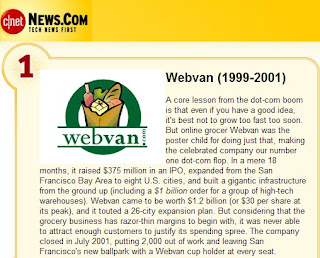Webvan delivers its last word: Bankruptcy
One of the greatest defunct Web sites and dotcom disasters, In June 2008, Webvan hailed by CNET as the top 1 dot com flops. In Webvan history, it was established in 1996, by Louis Borders, who also co-founded the Borders bookstore in 1971. Webvan was a pure-play Internet retailer, offering same-day delivery of general grocery merchandise. Webvan's original investors included Goldman Sachs and Yahoo!, who encouraged it to rapidly build its own infrastructure.
Webvan was headquartered in Foster City, California, USA, near Silicon Valley and had plans to expand the delivery to 26 cities. However, before it ceased operations in 2001, it had a opportunity to serve only eight U.S. markets: San Francisco Bay Area, San Diego, Los Angeles, Chicago, Seattle, Portland, Atlanta, and Orange County. Webvan went public in November 1999. However, Webvan’s business idea was to be stand-alone and build everything on its own. Webvan’s business model involved a hub-warehouse in the center where the products would be stored, transfer stations where items would be transported by the fleet of trucks serving an approximately 60-mile area. Webvan had a 24-hour online ordering system where customers could pick the time of delivery for their convenience and high-tech order-picking centers that supported online shopping activities. Webvan’s business model relied heavily on the sophisticated, highly automated information system which was supposed to automate supply chain management and coordinate delivery planning. Webvan tried to embrace a total customer satisfaction model involving a 30 minute window delivery.
Webvan took its first order on June 2, 1999. It kept growing and even acquired its competitor, HomeGrocer.com. On the 9th of July, 2001, once worth $1.2 billion, Webvan, the US online grocer filed for bankruptcy protection, shutting down its operations, laying off 2,000 staff and ending one of the most ambitious attempts to create a viable online retailer, reports the Financial Times. What went wrong with Webvan? The online grocery shopping seemed like a sound idea during the booming high-tech 90’s. Wasting about $1.2 billion of investors’ money, Webvan never delivered any profit. The critical cause the Webvan’s management made was to spend too much of the investors’ capital before there was even any revenue. An attempt to expand too quickly and get big fast is a well-known mistake of the dot-com companies at the time. Webvan spent too much on its sophisticated infrastructure in order to establish in multiple areas and the costs far exceeded the sluggish sales growth. The basic economic principle still stands in the e-business world: you have to make a profit eventually in order to succeed.
Nowadays, Webvan is become part of Amazon.com family, it uses the same great Amazon.com technology and features. Simply browse or search for the items the customers interested in. On the product detail pages, it show the comprehensive product details plus customer reviews from the Amazon.com community of customers, making it easier to find new products to try and offer the same high-quality customer service to it customers expect from Amazon.com, Webvan.com always available in 24 hours a day, seven days a week.
Top 10 dot-com flops-Top 1 Webvan.com
http://www.cnet.com/1990-11136_1-6278387-1.html
Webvan powered by Amazon WebStore
The greatest defunct Web sites and dotcom disasters-Webvan
http://crave.cnet.co.uk/gadgets/0,39029552,49296926-6,00.htm






2 comments:
I think companies like http://www.i-booze.com have learned from comapanies like Webvan and only sell products that people want right away.
Yup, Nowadays, there are many companies will start to question themselves, "what are the people needs and wants?" & "how to satisfy the people needs and wants" by learning mistake from many companies in last time like Webvan, therefore they can avoid from making more mistakes...
Post a Comment